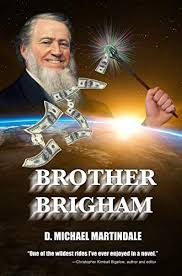Articles/Essays – Volume 41, No. 1
A Novel with a Lot of Way-Out-There Ideas | D. Michael Martindale, Brother Brigham
Joseph Smith received golden plates, magical translating devices, and countless visits from heavenly messengers, but a host of cognitive and cultural biases combine to render them almost commonplace in our collective Mormon memory. These supernatural events from Mormon history nestle up against ordinary moments from secular history like so many points on a timeline, one point seemingly no more extraordinary than the next: Andrew Jackson was elected U.S. president in 1828; Joseph Smith met Peter, James, and John in 1830; and so on.
But recast any of these same supernatural events with new characters in present-day Utah and their anomalous, singular qualities are given their proper jaw-dropping or head-scratching weight. This was the thought that occurred to me time and time again while reading D. Michael Martindale’s Brother Brigham, a novel packed with events that struck me as bizarre and even preposterous, only to be followed by the sobering realization that each event was based on either historical or scriptural pre cedent—in other words, no more bizarre than the original event itself.
In Brother Brigham, C. H. Young, a bright, twenty-something husband and father receives a visit from the not-yet-resurrected spirit of his great-great-grandfather, Brigham Young. Brigham tells C. H. of a cache of money hidden in the Utah desert that C. H. is to retrieve “for a wise purpose.” From there, the plot one-ups itself with each successive chapter as C. H. wages battle against both spiritual and flesh-and-blood opponents, with his eternal soul and the future of the Church at stake.
An author’s bio at the end of the novel notes that Martindale grew up with “a taste for science fiction and a love for telling speculative stories.” No kidding! Martindale mines Mormonism for all of the speculative tidbits that never see the light of day in Gospel Doctrine lesson manuals but which endlessly fascinate overzealous missionaries at the MTC or churn out fodder for fanatical bloggers. Take, for example, the “handshake test” found in Doctrine and Covenants 129, where evil spirits can be differentiated from good spirits based on the corporeal condition of the extended hand, a key plot device in the novel. Reading Brother Brigham I could imagine Martindale as an animated missionary, leading his fellow missionary roommates in late-night speculative discussions of the arcane and esoteric.
Like a Stephen King novel, perhaps, Brother Brigham has no real literary aspirations. Still one does not read a King novel for its prose or rich characterization, but rather for its propulsive, mind-bending plot. Here Martindale succeeds with page-turning gusto. Indeed, though I’ve never counted myself a fan of the science-fiction or fantasy genre, I found Martindale’s enthusiasm for his subject matter infectious. Speculative fiction fans will certainly embrace Brother Brigham as a welcome addition to the growing Mormon SF subgenre.
But non-SF readers need not pass up Brother Brigham, for at its heart Martindale’s story is also something of a romance novel, albeit from a decidedly male point of view. In that regard, Brother Brigham is pretty edgy stuff, if a Deseret Book novel is your primary frame of reference. C. H. is “called” upon by Brother Brigham to get his Big Love on, and C. H.’s sexy co-worker Sheila, an aggressive, promiscuous, inactive Mormon, is only too eager to be his mistress, or, what the heck, his second wife. If C. H. needs to rationalize extramarital sex with delusions of polygamous grandeur, who is Sheila to argue if the end result is the same? How C. H. convinces his wife Dani to go along with the plan and how C. H. maneuvers to marry Sheila polygamously in the Salt Lake Temple are two of Brother Brigham’s more exciting plot threads.
Brother Brigham’s handful of descriptive sex scenes (as well as its boundary-pushing speculative theology) seems to be in keeping with Zarahemla Books’ stated commitment toward more “frankness and realism, [and] earthier explorations of Mormon culture and experience.”[1] In other words, staid The Work and the Glory retreads need not apply. That said, Brother Brigham is never too steamy or too graphic. Anyone who has read Levi Peterson’s The Backslider or any number of popular Gentile mystery, crime, spy, science fiction, or romance novels, will not be put off by Martindale’s depictions of the “earthier” side of life.
So, if you are looking for something a little different from your typical Mormon novel, something with a little spice and a lotta way-out-there ideas, then Brother Brigham is for you. But be forewarned: set foot in Martindale’s world and you’d better have your spiritual house in order and be prepared to defend your family by calling on the powers of heaven. Where you’re going, you’re gonna need it!
D. Michael Martindale. Brother Brigham. Provo, Utah: Zarahemla Books, 2007. 258 pp., $15.95.
[1] Statement on Zarahemla Books webpage, http://zarahemlabooks. com/main.sc (accessed in August 2007).


 Back to full Issue
Back to full Issue

